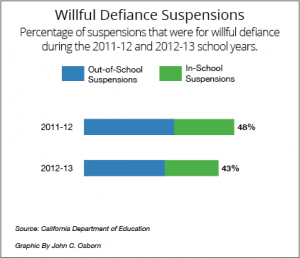
by Stephen Frank on 02/26/2014
San Francisco joins Los Angeles Unified, which eliminated the category of willful defiance of school authorities or disruptive behavior as a reason to expel or suspend students beginning this school year.â€
In simple language, yelling, screaming, refusing to sit down, refusing to stop talking, refusing to stop smoking in a classroom is no longer a reason for a San Fran student to be suspended or expelled. They join the out of control LAUSD classrooms in putting bullies and the vicious in charge of conduct in a classroom. This is another reason for parents to have School choiceif they want a quality education for their children, the school district has given the nasty control of the classrooms. Wonder why the teachers say nothing?
Oh, the reason for all this? Because too many of one background disrupt classrooms. As if race, national origin was an excuse to bully students or disrupt a classroom. Bigotry exists in San Frangood kids are discriminated against in their attempt to get a quality education. Shame.
San
Francisco Unified eliminates "willful defiance" as a reason to expel
or suspend students
By Susan Frey, EdSource, 2/26/14

The percentage of all suspensions that were for willful defiance dropped from 48 percent in 2011-12 to 43 percent in 2012-13.
Administrators in San Francisco Unified will no longer be able to use "willful defiance" as a reason to suspend or expel a student, beginning in the 2014-15 school year.
San Francisco's school board voted unanimously Tuesday to eliminate the controversial category, which has been used disproportionately to suspend African American students in that district and also statewide.
San Francisco joins Los Angeles Unified, which eliminated the category of willful defiance of school authorities or disruptive behavior as a reason to expel or suspend students beginning this school year.
Statewide, willful defiance accounted for 43 percent of all suspensions in 2012-13. African American students, who make up 6 percent of statewide enrollment, accounted for 19 percent of willful defiance suspensions.
In San Francisco, data show that African American students make up about 10 percent of the student body but account for more than half of suspensions and expulsions. Latino students also were disproportionately suspended.
In both San Francisco and Los Angeles, teachers can still remove a disruptive student by sending the student to the principal's office, to a counselor, or to another teacher's class. This is not considered a suspension because the student would miss only the one class. However, San Francisco's board plans to monitor data on such removals as well.
The district's decision is part of an overall plan to move to more positive disciplinary practices. Teachers will be trained in de-escalation techniques and other proven disciplinary approaches during the next three years. Because of the focus on training, the teachers' union, United Educators of San Francisco, supported the change in policy.
"Our district is unified and committed to supporting our teachers with the tools they need to educate all of our students," said Commissioner Matt Haney, who introduced the "Safe and Supportive Schools" resolution. "There's a lot of hard work left to do, but we're ready for it."
Michael Britt, who teaches math at Burton High School, came to the board meeting to offer his support of the resolution.
"We are in the business of building young men and women," he said in prepared remarks. "Our policies and practices should reflect that mission and deserve serious evaluation when they do not."
"We need to be keeping our kids in the classroom, Britt told EdSource. He said some of the changes in approach that teachers can make are simple, such as using positive, rather than negative, narration. "I never tell my kids to stop talking. I tell them what they should be doing. I'll say, I'm looking at you to do problem number 1."
Students will still be held accountable for their behavior and, under the restorative justice approach to discipline, will have to make amends for their bad deeds. For example, if a student disrupts a class, he could apologize to his classmates and teacher and stay after school to help the teacher prepare for the next day.
"It's a different system of accountability," said Laura Faer, an attorney with the public interest law firm Public Counsel, which has been advocating for the change in policy. Students often see suspensions as unsupervised vacations, she said, but in many communities students are at risk of becoming victims of violence or part of the juvenile justice system when they are sent home from school. Research has shown that students who are suspended are more likely to drop out of school and end up incarcerated.
With restorative justice, "they are held accountable to their peers and to their community," she said. "We need to teach them and work with them and hold them closer so they can succed"
If two of the state's largest districts, which educate many students who come from violent and impoverished communities, can make this change, Faer said she is hopeful that more districts will follow.
An EdSource analysis of the 30 largest districts found huge disparities in their reliance on willful defiance to suspend students, with some districts citing it as the reason for more than two-thirds of their suspensions, and others less than a third. Statewide, suspensions for willful defiance dropped from 48 percent of all suspensions in 2011-12 to 43 percent in 2012-13.
Britt said he is glad his district is being a leader on this issue. "We've been on the wrong side," he said. "We want to be one of the first districts to move in the right direction."